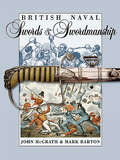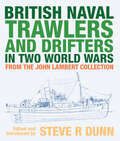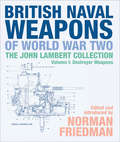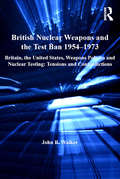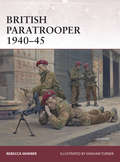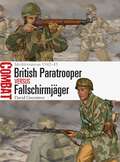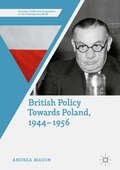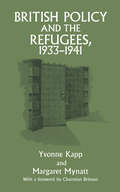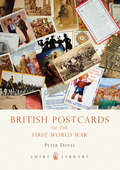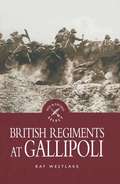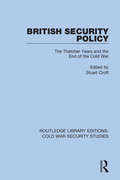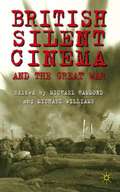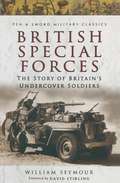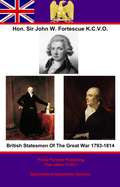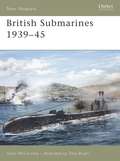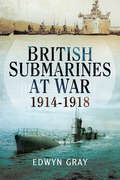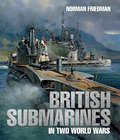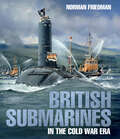- Table View
- List View
British Naval Strategy East of Suez, 1900-2000: Influences and Actions (Cass Series: Naval Policy And History Ser. #Vol. 27)
by Greg KennedyThis new collection of essays by a panel of established international scholars sheds new light on what some of those influences were and what actions were taken as a result of Britain's Far Eastern commitments. Not only are new evidence and approaches to those issues addressed presented, but new avenues for further research are clearly outlined. Th
British Naval Supremacy and Anglo-American Antagonisms, 1914-1930
by Donald J. Lisio"During World War I, British naval supremacy enabled it to impose economic blockades and interdiction of American neutral shipping. The United States responded by building 'a navy second to none,' one so powerful that Great Britain could not again successfully challenge America's vital economic interests. This book reveals that when the United States offered to substitute naval equality for its emerging naval supremacy, the British, nonetheless, used the resulting two major international arms-control conferences of the 1920s to ensure its continued naval dominance"--
British Naval Swords and Swordmanship
by John McGrath Mark BartonThis new publication is intended to bring together a mass of research dealing with all aspects of British naval swords. Unlike the much sought after Swords of Sea Service by May and Annis, this work offers a far broader coverage and, for the first time, the complete story of swords and swordsmanship is presented in one concise volume. While the swords themselves are described the authors also tell the story of naval swordsmanship For exsample, subjects such as how swords and cutlasses were used in action and how training was conducted and covered. The authors also address how how the use of swords developed into a sport in the Navy, and how swords and swordsmanship may have entered naval symbology in such areas as ships' names. Many current myths are addressed and corrected, and the story is brought right up to date with information on the sport from 1948 to 2000. While the book concentrates on the Royal Navy, foreign weapons, including those of the Irish Naval Service, are mentioned where appropriate Other British Maritime organisations such as the Merchant Navy, the Customs and Coastguard Services, and the Reserves are also addressed The book also covers subjects such as dating, collecting, and conservation of swords and re-examines those swords attributed to Nelson. The Appendices include the first list of Swords of Peace awarded to naval units to be published. Recent research by the authors is also reflected in the updated lists of Patriotic Fund Awards, City of London Swords, and Naval fencing champions contained in the Appendicitises The comprehensive nature of the work has not been attempted before and the book will appeal to a wide range of naval enthusiasts and historians, collectors of weapons, fencers and re-enactors.
British Naval Trawlers and Drifters in Two World Wars: From The John Lambert Collection
by Steve DunnJohn Lambert was a renowned naval draughtsman, whose plans were highly valued for their accuracy and detail by modelmakers and enthusiasts. By the time of his death in 2016 he had produced over 850 sheets of drawings, many of which have never been published. These were acquired by Seaforth and this title is the fourth of a planned series of albums on selected themes, reproducing complete sheets at a large page size, with expert commentary and captioning. Trawlers and drifters served in both world wars in their thousands; and, in their tens of thousands, so did their fishermen crews. Indeed, these humble craft were the most numerous vessel type used by the Royal Navy in both wars, and were the answer to the strategic or tactical conundrums posed by new technology of mines and submarines. In his accompanying text, Steve Dunn examines the ships themselves, their design, construction, arming, operations and development; and he also relates how the trawlermen and skippers, from the age-old fishing ports of Grimsby, Hull, Lowestoft ad Great Yarmouth, Aberdeen and Fleetwood, came to be part of the Royal Navy, and describes the roles they played, the conditions they served under and the bravery they showed. The book takes some 30 large sheets of drawings which John Lambert completed of these vessels and divides into two sections. The first part tells how the fishing fleet came to be an integral part of the Royal Navy’s pre-1914 plans and details some of the activities and actions of trawlers and drifters at war in 1914-18. And the second investigates the armed fishing fleet in the struggle of 1939-45. These wonderfully detailed drawings, which are backed by a selection of photographs and a detailed complementary text, offer a superb technical archive for enthusiasts and ship modellers, but the book also tells a fascinating story of the extraordinary contribution the vessels and their crews made to the defeat of Germany in two world wars.
British Naval Weapons of World War Two, Volume I: Destroyer Weapons (The John Lambert Collection)
by Norman Friedman&“For anyone wishing to super-detail any British destroyer of this era, this book looks to be a real must-have.&” —Nautical Research Guild's Model Ship World John Lambert was a renowned naval draftsman, whose plans were highly valued for their accuracy and detail by modelmakers and enthusiasts. By the time of his death in 2016 he&’d produced over 850 sheets of drawings, many of which have never been published—until now. Lambert&’s interest was always focused on smaller warships and his weapons drawings tend to be of open mountings—the kind that present a real challenge to modelmakers—rather than enclosed turret guns, but he also produced drawings of torpedo tubes, underwater weapons, fire-control directors, and even some specific armament-related deck fittings. This first volume in a series covers all such weapons carried by British destroyers of this era, with additional appendices devoted to earlier guns still in service, and destroyer-caliber weapons only mounted in larger ships. The drawings are backed by introductory essays by Norman Friedman, an acknowledged authority on naval ordnance, while a selection of photographs add to the value of the book as visual reference.
British Naval Weapons of World War Two, Volume III: Coastal Forces Weapons (The John Lambert Collection #3)
by Norman Friedman“Lambert was a drafter of no mean skill . . . his drawings are concise, clear, and invaluable to scratchbuilders and super-detailers. Very highly recommended!” —Nautical Research JournalJohn Lambert was a renowned naval draftsman whose plans were highly valued for their accuracy and detail by modelmakers and enthusiasts. By the time of his death in 2016 he had produced over 850 sheets of drawings, many of which had never been published. Now they have become available in these remarkable collections, with expert commentary and captioning included. The initial volumes concentrate on British naval weaponry used in the Second World War, thus completing the project Lambert was working on when he died. His interest was always focused on smaller warships and his weapons drawings tend to be of open mountings—the kind that present a real challenge to modelmakers—rather than enclosed turret guns, but he also produced drawings of torpedo tubes, underwater weapons, fire-control directors, and even some specific armament-related deck fittings. Following the earlier volumes on destroyer and escort armament, this one covers the multitude of weapons carried by Coastal Forces, many of which were improvised, ad hoc, or obsolescent, but eventually led to powerful purpose-designed weaponry. An appendix covering the main deck guns carried by British submarines of this era is included, along with an introductory essay by naval ordnance authority Norman Friedman and a selection of photos.
British Nuclear Weapons and the Test Ban 1954-1973: Britain, the United States, Weapons Policies and Nuclear Testing: Tensions and Contradictions
by John R. WalkerIn 1962 Dean Acheson famously described Britain as having lost an Empire but not yet found a role. Perhaps nowhere is this more apparent than in the realms of nuclear weapons. An increasingly marginal world power, successive post-war British governments felt that an independent nuclear deterrent was essential if the country was to remain at the top table of world diplomacy. Focusing on a key twenty-year period, this study explores Britain's role in efforts to bring about a nuclear test ban treaty between 1954 and 1973. Taking a broadly chronological approach, it examines the nature of defence planning, the scientific goals that nuclear tests were designed to secure, Anglo-American relationships, the efficacy of British diplomacy and its contribution to arms control and disarmament. A key theme of the study is to show how the UK managed to balance the conflicting pressures created by its determination to remain a credible nuclear power whilst wanting to pursue disarmament objectives, and how these pressures shifted over the period in question. Based on a wealth of primary sources this book opens up the largely ignored subject of the impact of arms control on the UK nuclear weapons programme. Its appraisal of the relationship between the requirements and developments of the UK nuclear weapons programme against international and domestic pressures for a test ban treaty will be of interest to anyone studying post-war British defence and foreign policy, history of science, arms control, disarmament and non-proliferation and international relations. It also provides important background information on current events involving nuclear proliferation and disarmament.
British Paratrooper 1940-45
by Rebecca SkinnerThis new history of the British Paratrooper, from 1940 to 1945, details the unique training, weapons and equipment used by these elite troops. Inspired by the exploits of the German Fallschirmjäger in the blitzkrieg campaigns, Winston Churchill called for the formation of a 5,000-strong Airborne Force in June 1940. From these beginnings the Parachute Regiment became one of the foremost units of the British Army both in World War II and up to the present day. A wealth of first-hand and until now unpublished materials brings the history of the ordinary Para to life, drawing on the author's position as a curator of the Regimental Museum. Illustrations and photographs illuminate the equipment and combat performance of the elite 'paras' in the context of some of the most significant campaigns of World War II, including D-Day and Operation market-garden.
British Paratrooper vs Fallschirmjager
by Johnny Shumate David GreentreeBy late 1942 Britain had developed an airborne capability that would obtain its baptism of fire versus German airborne in North Africa and Sicily. On three notable occasions British airborne infantry fought intense battles with its German counterpart: twice in North Africa and again at Primosole Bridge in Sicily. Both forces were well trained and equipped, with a similar ethos and role, both thought of themselves as elite units, and both found themselves used by local commanders in a variety of roles that tended to be determined by the emergencies of the moment.On 29 November 1942 Lt Col Frost's 2nd Para dropped at Depienne, Tunisia, with orders to march overnight to Oudna, destroy the aircraft there and then return to Allied lines. Finding no aircraft they retreated, repeatedly combating elements of Oberst Koch's FJR 5, deployed in a ground role. 2nd Para ambushed and drove back Fallschirmjäger riding on armoured cars. Nearly surrounded, Frost withdrew to a nearby hill; a battle ensued as both sides raced for the crest. After retreating overnight 2nd Para wiped out an attacking German platoon, and on 3 December Frost's men finally reached Allied lines; all told, they had made five night marches and fought three battles, in total covering 50 miles, and only 180 of Frost's 450 men remained effective.Fighting as infantry, elements of 3rd Para encountered two companies of Fallschirmjäger-Pionier Bataillon, supported by elements of armour and artillery, in a strongly fortified position at Djebel Azag. On the night of 4/5 January 1943 a see-saw battle took place as the hill changed hands. The Germans were able to retain this key position. After weeks of further bitter fighting the British parachute brigade was again pulled out of the line in March 1943, but there would be no respite for any of the German parachute units; in May nearly all of those who had survived became POWs.On the night of 13/14 July 1943, 1st Para Brigade dropped to seize the Primosole Bridge in Sicily and hold it until relieved the next day by 50th Division. Unknown to Allied planners, though, Fallschirmjager dropped nearby in the last large-scale German airdrop of WWII. The Allied airborne was badly dispersed by AA fire. However, the British successfully seized the bridge and held it until an improvised counter-attack retook it. Midway through the evening of 14 July elements of 50th Division succeeded in relieving the Paras, retaking the bridge after 2 more days of bitter fighting. The Germans withdrew after failing to destroy the bridge with a truck-borne improvised explosive device.The battle at Primosole Bridge had immediate strategic consequences for both sides: for Britain an inquiry was held as to whether airborne forces were worth the investment, while for Germany the engagement proved the concept that elite infantry capable of being transported quickly by air to hotspots in the line could avert disaster. Featuring vivid first-hand accounts, specially commissioned full-colour artwork and in-depth analysis, this is the gripping story of the clash between airborne forces at the height of WWII.
British Policy Towards Poland, 1944–1956 (Security, Conflict and Cooperation in the Contemporary World)
by Andrea MasonThis book examines the outcome of the British commitment to reconstitute a sovereign Polish state and establish a democratic Polish government after the Second World War. It analyses the wartime origins of Churchill’s commitment to Poland, and assesses the reasons for the collapse of British efforts to support the leader of the Polish opposition, Stanisław Mikołajczyk, in countering the attempt by the Polish communist party to establish one-party rule after the war. This examination of Anglo-Polish relations is set within the broader context of emerging early Cold War tensions. It addresses the shift in British foreign policy after 1945 towards the US, the Soviet Union and Europe, as British leaders and policymakers adjusted both to the new post-war international circumstances, and to the domestic constraints which increasingly limited British policy options. This work analyses the reasons for Ernest Bevin’s decision to disengage from Poland, helping to advance the debate on the larger question of Bevin’s vision of Britain’s place within the newly reconfigured international system. The final chapter surveys British policy towards Poland from the period of Sovietisation in the late 1940s up to the October 1956 revolution, arguing that Poland’s process of liberalisation in the mid-1950s served as the catalyst for limited British reengagement in Eastern Europe.
British Policy and the Refugees, 1933-1941
by Yvonne Kapp Margaret MynattIn the summer of 1940, with much of Europe under German domination, British authorities instigated a harsh programme of internment or deportation of those who had fled Nazi oppression. This volume, written the same year, is a critique of government policies of the day.
British Postcards of the First World War
by Peter DoylePostcards sent by men on the front, and to them by their families, are among the most numerous, and most telling, surviving artifacts of World War I. They tell us much about attitudes towards the war, and provide a great insight into men's lives, and into the thoughts and emotions of those left behind. Very different in their illustration, and in their writing, between the beginning of the war and the end, the postcard provides a social history of the war in microcosm. Illustrated with a wide range of postcards, this book is a perfect introduction to the subject for the collector, and will help any family or social historian to gain a better understanding of the postcards in his possession.From the Trade Paperback edition.
British Redcoat 1740-93
by Richard Hook Stuart ReidDuring this period, the British army earned itself a formidable reputation as a fighting force. However, due to its role as a police force at home, and demonisation by American propaganda during the American Revolution (1763-1776), the army was viewed as little removed from a penal institution run by aristocratic dilettantes. This view, still held by many today, is challenged by Stuart Reid, who paints a picture of an increasingly professional force. This was an important time of change and improvement for the British Army, and British Redcoat 1740-1793 fully brings this out in its comprehensive examination of the lives, conditions and experiences of the late 18th-century infantryman
British Regiments at Gallipoli
by Ray WestlakeFollowing the success of British Battalions on the Somme, the author has produced a source book of the same quality on the Gallipoli Campaign. It has come about as a result of many years of enquiries from researchers and family historians.
British Security Policy: The Thatcher Years and the End of the Cold War (Routledge Library Editions: Cold War Security Studies #7)
by Stuart CroftThis book, first published in 1991, examines Britain’s defence and foreign policy of the 1980s , and explores a variety of alternative roles for Britain in the radically changed circumstances of the 1990s. The authors analyse the full range of major British security issues and developments, including the use of force and the role of conventional forces, the significance of the Anglo-American special relationship, relations with Europe, the Third World and the Soviet Union, and the unique problem of Northern Ireland. They particularly address the question of whether international policy in ‘the Thatcher years’ has marked a decisive break with earlier post-war policy or has rather been marked by shifts of emphasis within an essentially stable framework.
British Silent Cinema and the Great War
by Michael Williams Michael HammondThis book presents a unique insight into an extraordinary period of European history that had far-reaching significance for British cinema andfor the way history itselfis represented. The work collected in this volume draws from the best knowledge, enthusiasm and critical insight of leading scholars, archivists and historians specialising in British cinema. The editors are experts in the field of British silent cinema; in particular, its complex relationship to the Great War and its afterimage in popular culture. As the Great Warcontinues tofade from living memory, it is a significant task to look back at how the cinema industry responded to that conflict as it unfolded, and how it shaped the war's memory through the 1910s and 1920s. "
British Sloops and Frigates of the Second World War (ShipCraft #27)
by Les BrownThe ‘ShipCraft’ series provides in-depth information about building and modifying model kits of famous warship types. Lavishly illustrated, each book takes the modeler through a brief history of the subject, highlighting differences between ships and changes in their appearance over their careers. This includes paint schemes and camouflage, featuring color profiles and highly detailed line drawings and scale plans. The modeling section reviews the strengths and weaknesses of available kits, lists commercial accessory sets for super-detailing of the subjects, and provides hints on modifying and improving the basic kit. This is followed by an extensive photographic gallery of selected high-quality models in a variety of scales, and the book concludes with a section on research references – books, monographs, large-scale plans and relevant websites. This volume covers the majority of British wartime escort classes, from the inter-war ASW and minesweeping sloops that culminated in the superb Black Swan class, to the wartime designs that were originally known as ‘twin-screw corvettes’ but were eventually classed as frigates – the ‘River’ class, and their derivatives of the ‘Loch/Bay’ classes that were modified for prefabricated construction. Also included are the American-built destroyer escorts which became RN ‘Captains’ class frigates and the earlier ex-US Coast Guard cutters that were listed as sloops. With its unparalleled level of visual information – paint schemes, models, line drawings and photographs – this book is simply the best reference for any model-maker setting out to build any of these numerous escort types.
British Special Forces
by William SeymourThis deeply researched and authoritative book has long been awaited by all those interested in the wartime exploits of the British Special Forces. For the first time readers will be able to understand the origin, inter- relationship and special functions of all the main units within the Special Force throughout the Second World War and after it. William Seymour identifies the principal leaders and tells of their triumphs, failures and frustrations, all set against the backcloth of the main strategic events in the Western Desert, Italy, the Eastern Mediterranean, Western Europe and the Far East.
British Special Forces: The Story of Britain's Undercover Soldiers
by William SeymourThis is the first comprehensive history of all the British Special Forces, from their beginnings during the Second World War to the Falklands War. The birth of many of the Special Forces was controversial—they were accused of being 'private armies' and a waste of valuable manpower that could have been better used within the regular forces. Their existence was justified only by their successes. The secrecy that still surrounds some of the Special Forces makes writing an authoritative history no easy task. William Seymour's fascinating narrative draws on a wide variety of documentary sources and eye-witness accounts from surviving members of the Forces. The Special Forces covered are: The Commandos, the Special Boat Section, Combined Operations Pilotage Parties, the Long Range Desert Group, Popski's Private Army, The Special Air Service, the Special Boat Squadron and Raiding Forces, and the Royal Marines Special Forces. From the chaungs of Burma to the African desert, the Greek islands to the D-Day landing beaches, Special Forces played a vital part in Allied victory in the Second World War.
British Statesmen Of The Great War 1793-1814
by Hon. Sir John William Fortescue K.C.V.O.This ebook is purpose built and is proof-read and re-type set from the original to provide an outstanding experience of reflowing text for an ebook reader. Sir John Fortescue, widely known for his multi-volume history of the British Army was invited to give the Ford lecture in 1911, he choose for his subject the British political figures who guided Britain through the Napoleonic Period. The French revolutionary wars and the Napoleonic wars spanned more than twenty years of conflict, broken only by sporadic periods of peace, it was rightly known until the advent of the First World War as the Great War in the United Kingdom. However the biographies for these figures who sent the controlled the war effort were thin on the ground; although they sent expeditions, regulated the finances of the nation and decided which general would command the troops they remained somewhat shadowy figures. Sir John set out to shed some light on the men set the wheels in motion to enable the victory of British forces in 1814 and 1815; their diplomacy, their war aims, relations with each other and with their commanders in the field. Men such as Fox, Canning, Grenville, Dundas, Windham, Lord Rosebery, Lord Liverpool, Pitt, Lord Castlereagh are all brought to life with an eye for clarity, distilling years of research into a pithy summary of the characters of the age the political background. Sir John is even with his praise and condemnation of the action of the ministers and figures that he shines his spotlight on, so although the focus is on the British politicians, the heads of other competing states are given their due. Text taken, whole and complete from the 1911 edition, Clarendon Press, Oxford. Original -279 pages Author - Hon. Sir John William Fortescue K.C.V.O. - (28th December 1859 - 22nd October 1933) Linked TOC.
British Strategy and War Aims 1914-1916 (Routledge Library Editions: The First World War)
by David FrenchThis book illustrates the relationship between British military policy and the development of British war aims during the opening years of the First World War. Basing his work on a wide range of unpublished documentary sources, David French reassesses for the benefit of students and scholars alike what was meant by ‘a war of attrition’.
British Submarines 1939-45
by Tony Bryan Innes MccartneyThe submarine was as formidable a weapon for the Royal Navy in World War II as for the other main combatant nations. The first half of this book explores the conception, design, development and subesequent evolution of the three major classes: the "S", "T", and "U".The "S" Class submarine was originally conceived in the 1920s, specifically for deployment in narrow seas. As the war progressed the submarine was modified to increase its diving capability and fuel-carrying capacity, and radar and many other features were added. The "S" Class served in all theaters from the North Atlantic to the Pacific with notable success, in many cases surviving very severe damage.The "T" Class submarine was originally conceived for operations in the Far East, thus was one of the largest types to be built and serve in World War II. The development of the "T" Class during the war was sometimes at the expense of its underwater stability and in the Mediterranean theater half of the submarines that were deployed sunk.The "U" Class include Upholder, the most successful British submarine of World War II.The second half of the book surveys the major submarine actions of the war, including the Norwegian Campaign, operatins to save Malta and many other engagements in all theaters involving British submarines, German U-Boats and the Japanese. The author has accessed many previously unpublished sources and draws on his own extensive underwater research to give a highly detailed and informed account of the British submarine.
British Submarines at War: 1914-1918
by Edwyn GrayOriginally published in 1970 and out of print for nearly thirty years, this book has already earned its place as a classic of submarine history by an author with an international reputation for being second-to-none in evoking the claustrophobic horror of war beneath the waves. Accurate in detail, yet written with humanity and humour, it tells the story of Britains pioneer submarines during the 1914-1918 War during which their crews battled courageously in atrocious conditions against a skilled and ruthless enemy and an equally unforgiving sea.2001 marks the centenary of Britains Submarine Service introduced into the Royal Navy in the face of opposition from virtually every flag officer in the fleet. The dedicated enthusiasts who made up their crews were derided as members of The Trade but they fought the Edwardian Naval Establishment as fiercely as they were later to fight the enemy; And Victory was their reward on both occasions. Freshly illustrated, this second edition is a timely tribute to the gallant pioneers who created the legacy of dogged courage, determination, and standards of excellence which remain the proud hallmarks of the Royal Navys submarine service today.
British Submarines in Two World Wars
by Norman FriedmanAn &“indispensable&” guide to the Royal Navy&’s submarines through 1945, with numerous photos and original plans (The Naval Review). The Royal Navy didn&’t invent the submarine—but in 1914, Britain had the largest submarine fleet in the world, and at the end of World War I it had some of the largest and most unusual of all submarines—whose origins and designs are all detailed in this book. During the First World War they virtually closed the Baltic to German iron ore traffic, and blocked supplies to the Turkish army at Gallipoli. They were a major element in the North Sea battles, and fought the U-boat menace. During World War II, US submarines were known for strangling Japan, but lesser known is the parallel battle by British submarines in the Mediterranean to strangle the German army in North Africa. Like their US counterparts, interwar British submarines were designed largely with the demands of a possible Pacific War, though that was not the war they fought. The author also shows how the demands of such a war, fought over vast distances, collided with interwar British Government attempts to limit costs. It says much about the ingenuity of British submarine designers that they met their requirements despite enormous pressure. The author shows how evolving strategic and tactical requirements and evolving technology produced successive types of design. British submariners contributed much to the development of anti-submarine tactics and technology, beginning with largely unknown efforts before World War I. Between the wars, they exploited the new technology of sonar (Asdic), and as a result pioneered submarine silencing, with important advantages to the US Navy as it observed the British. They also pioneered the vital postwar use of submarines as anti-submarine weapons, sinking a U-boat while both were submerged. Heavily illustrated with photos and original plans and incorporating much original analysis, this book is ideal for naval historians and enthusiasts. &“Sure to become the standard reference for British submarine development for years to come&” —Warship
British Submarines in the Cold War Era
by Norman FriedmanThe first comprehensive technical history on the subject, with photos: &“A must-read for all professionals, designers and scholars of modern submarines.&” —Australian Naval Institute The Royal Navy&’s greatest contribution to the Allied success in World War II was undoubtedly the defeat of the U-boat menace in the North Atlantic, a victory on which all other European campaigns depended. The underwater threat was the most serious naval challenge of the war, so it was not surprising that captured German submarine technology became the focus of attention for the British submarine service after 1945. It was quick to test and adopt the schnorkel, streamlining, homing torpedoes, and, less successfully, hydrogen-peroxide propulsion. Furthermore, in the course of the long Atlantic battle, the Royal Navy had become the world&’s most effective anti-submarine force and was able to utilize this expertise to improve the efficiency of its own submarines. However, in 1945 German submarine technology had also fallen into the hands of the Soviet Union—and as the Cold War developed it became clear that a growing Russian submarine fleet would pose a new threat. Britain had to go to the US for its first nuclear propulsion technology, but the Royal Navy introduced the silencing technique that made British and US nuclear submarines viable anti-submarine assets, and it pioneered in the use of passive—silent—sonars in that role. Nuclear power also changed the role of some British submarines, which replaced bombers as the core element of British Cold War and post-Cold War nuclear deterrence. As in other books in this series, this one shows how a combination of evolving strategic and tactical requirements and new technology produced successive types of submarines. It is based largely on unpublished and previously classified official documentation, and to the extent allowed by security restrictions, also tells the operational story—HMS Conqueror is still the only nuclear submarine to have sunk a warship in combat, but there are many lesser-known aspects of British submarine operations in the postwar era.


